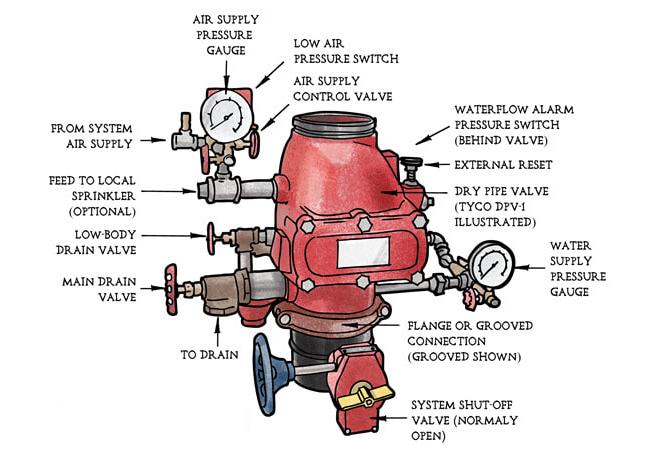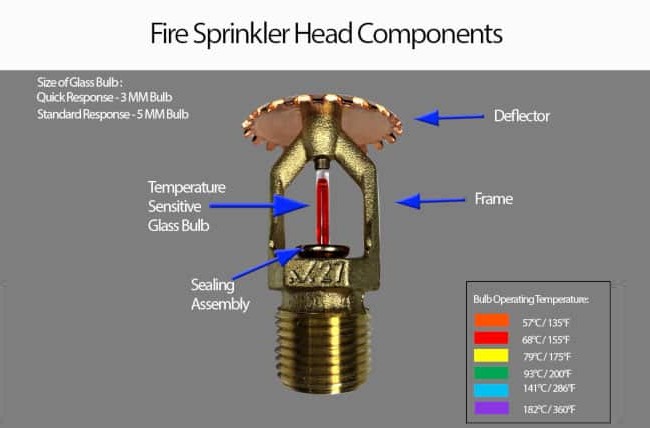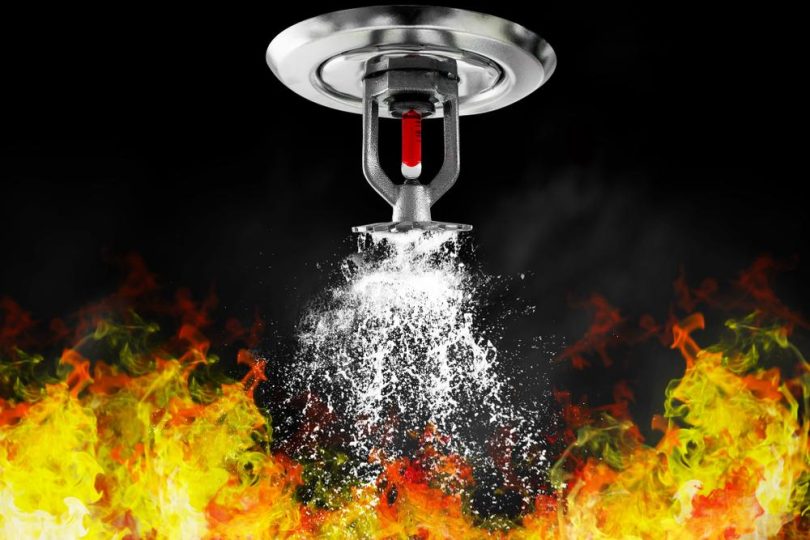A fire sprinkler system is a protection measure to protect against fires. The sprinkler system consists of a water supply system that provides enough pressure and flow to a water distribution piping system.
Fire sprinklers are attached to this piping system. They distribute water onto a ceiling, where the water then falls to the floor and is absorbed.
So, how do these sprinklers work?
Different Components of the Fire Sprinkler System

A fire sprinkler system consists of two main components: the water supply system and the fire sprinkler head. While each part is straightforward seeming, there is a lot going on with each one.
1. Water Supply System
The water supply system is the part of the fire sprinkler system that supplies water to the sprinkler heads. The system includes a water source, a pump, and a pressurized tank.
a) Water Source
The water source is where the fire sprinkler system gets the water that will be poured onto the fire. It can be a municipal water supply, a private water supply, or a natural water source such as a river or lake.
b) Pump
The pump is used to pump water from the water source to the pressurized tank.
c) Pressurized Tank
The pressurized tank is used to store water under pressure. When the system is activated, the water in the tank is released and flows through the piping to the sprinkler heads.
2. Fire Sprinkler Head

The fire sprinkler head is the part of the fire sprinkler system that releases water onto the fire. The head is attached to the piping and is activated when the surrounding temperature reaches a predetermined point.
When the head is activated, a plug is released and water flows from the piping and onto the fire.
Work Principle of A Fire Sprinkler System
A fire sprinkler system is a system that uses water to extinguish fires. It consists of a water supply system, a piping system, and fire sprinklers. It is commonly used in large commercial buildings, but systems for smaller buildings are now available.
Detection
The first step in the operation of a fire sprinkler system is the detection of a fire. Modern sprinkler heads are heat-sensitive and designed to activate when they reach a predetermined temperature. This temperature is between 135–165 °F (57–74 °C) for standard sprinklers and between 155–200 °F (68–93 °C) for quick-response sprinklers.
Activation
When the sprinkler head reaches the predetermined temperature, a fusible element within the head melts, allowing a plug to be released. This plug had previously held a pin in place, which was holding a deflector plate over the sprinkler orifices. The sudden release of the plug and pin causes the deflector plate to be forced open by a spring, exposing the orifices.
Pressurized Sprinkling
The sudden opening of the orifices causes a sudden drop in pressure in the piping system. This pressure drop is detected by a pressure switch, which activates an alarm and starts a pump. The pump pressurizes the system, which had been previously filled with water, to its designed operating pressure. Once the system is pressurized, water flows from the piping through the open orifices and onto the fire.
After Dousing Fire
Once the fire has been extinguished, the water flow to the sprinkler heads is shut off. However, the water flow from the sprinkler heads continues until the heat from the fire has lowered the temperature of the sprinkler heads to below their activation point. This is to ensure that any hidden fire is discovered and extinguished.
Different Types of Fire Sprinkler Systems and How They Work
There are four main types of fire sprinkler systems: wet, dry, pre-action, and deluge.
1. Wet Pipe Sprinkler System
This is the most common type of fire sprinkler system. As the name suggests, a wet pipe system always keeps water in the pipes. When a fire activates the sprinkler head, the water is immediately released onto the fire.
2. Dry Pipe Sprinkler System
A dry pipe system does not always keep water in the pipes. Instead, the pipes are filled with pressurized air. When a fire activates the sprinkler head, the pressurized air is released and allows water to flow into the pipes and onto the fire.
3. Pre-Action Sprinkler System
A pre-action system is like a dry pipe system in that the pipes are not always filled with water. However, a pre-action system also has a detection system that must sense a fire before the sprinklers will activate. When the detection system senses a fire, it will release the pressurized air and allow water to flow into the pipes and onto the fire.
4. Deluge Sprinkler System
A deluge system is like a wet pipe system in that the pipes are always filled with water. However, a deluge system does not have heat-sensitive sprinkler heads. Instead, the entire system is activated when the detection system senses a fire. When the system is activated, all the sprinklers will open and release water onto the fire.
FAQs
1. What temperature will set off a fire sprinkler?
Ans. The temperature that will set off a fire sprinkler depends on the type of sprinkler head. Standard sprinkler heads are designed to activate at a temperature of 135–165 °F (57–74 °C), while quick-response sprinkler heads are designed to activate at a temperature of 155–200 °F (68–93 °C).
2. How much does it cost to install a fire sprinkler system?
Ans. The cost to install a fire sprinkler system depends on the size and type of system. Generally, a wet pipe system is the most expensive to install, followed by a dry pipe system, a pre-action system, and a deluge system.
This is because the wet pipe system has the most work since it is filled with water and you do not want it to freeze. The dry pipe system is next because it must be filled with pressurized air, which is expensive. The pre-action system is next, because it has a separate detection system, so it is cheaper than the dry pipe system. The last is the deluge system – the easiest to get ready and the cheapest to install.
3. Do fire sprinklers react to smoke?
Ans. Fire sprinklers are designed to activate when they reach a predetermined temperature. However, some sprinkler heads are also designed to activate when they sense smoke.










Leave a Comment